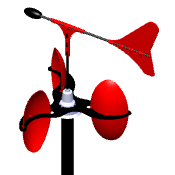Selecting the Right Anemometer: A Comprehensive Purchasing Overview
Selecting the Right Anemometer: A Comprehensive Purchasing Overview
Blog Article
All You Need to Find Out About Anemometers: Just How They Work, Why They Matter, and Where to Use Them
Anemometers, though often overlooked in the world of clinical instruments, play an essential function in different areas, using beneficial understandings right into wind speed and airflow patterns. Recognizing the mechanics behind these devices is crucial for anybody looking for to harness the power of this data. From meteorologists tracking climate patterns to designers creating frameworks with wind tons in mind, the applications of anemometers are diverse and far-ranging. As we delve right into the complexities of anemometer modern technology, we will certainly uncover the inner workings of these devices, their importance, and the crucial factors to consider when choosing the appropriate anemometer for certain applications.

Anemometer Essentials
A crucial tool used to measure wind speed and instructions, the anemometer plays a crucial function in meteorology and various industries. An anemometer commonly is composed of three or four cups that rotate in the wind, a vane that aims into the wind, and sensors to track the turnings or movements.
There are different kinds of anemometers offered, consisting of cup anemometers, vane anemometers, hot-wire anemometers, and sonic anemometers, each with its one-of-a-kind functions and applications. Mug anemometers are generally made use of for standard wind rate dimensions, while vane anemometers are preferred for directional dimensions. Hot-wire anemometers appropriate for low airspeeds, and sonic anemometers are ideal for high-precision measurements in research study and industrial setups. Recognizing the fundamentals of anemometers is essential for accurate wind information collection and analysis across various markets.
Concepts of Anemometer Operation
Structure on the fundamental understanding of anemometer essentials, the concepts of anemometer procedure elucidate the technicians behind wind speed and direction measurements. Cup anemometers, for instance, have three or more cups that capture the wind, triggering them to spin quicker as the wind rate boosts. Hot-wire anemometers depend on a warmed wire that cools down as wind passes over it, with the price of cooling determining the wind speed.
Importance of Anemometers
Anemometers play a critical function in gauging wind speed and direction, supplying essential data for weather projecting, environment studies, ecological surveillance, and aeronautics procedures. Meteorologists rely on anemometers to collect precise pop over to this web-site wind data, aiding them comprehend weather condition patterns, anticipate storms, and issue timely cautions to the public. Wind ranch drivers use anemometers to examine wind conditions and take full advantage of electrical energy manufacturing from wind generators.
Applications Across Various Industries
In the eco-friendly power sector, anemometers play a vital function in assessing wind conditions for wind farm placements, ensuring ideal energy production. Industries like construction and mining utilize anemometers to keep an eye on wind rates, vital for security procedures, specifically when functioning at heights or in open-pit mines where solid winds can present dangers. In farming, anemometers aid farmers in handling crop splashing by giving real-time information on wind rate to prevent drift.

Selecting the Right Anemometer for Your Demands
Selecting the appropriate anemometer tailored to your certain needs is vital for getting accurate wind speed and direction dimensions. When picking an anemometer, take into consideration elements such as the designated application, needed measurement variety, ecological conditions, and desired attributes. For basic functions, a mug anemometer is ideal for determining wind rate, while a vane anemometer gives wind direction data. Hot-wire anemometers are ideal for low airspeed measurements, and ultrasonic anemometers offer high accuracy and longevity.

Final Thought
Finally, anemometers play an essential function in measuring wind rate and direction throughout different markets. Understanding the concepts of anemometer operation is essential for picking the appropriate gadget for specific demands. From meteorology to aeronautics, anemometers are essential devices for collecting exact data and ensuring safety and security in different applications. When selecting the most ideal tool for measuring wind conditions., it is crucial to consider the importance of anemometers in order to make educated decisions.
There are numerous Learn More kinds of anemometers available, consisting of mug anemometers, vane anemometers, hot-wire anemometers, and sonic anemometers, each with its distinct functions and applications. Mug anemometers are generally Full Report made use of for standard wind rate dimensions, while vane anemometers are liked for directional dimensions. Hot-wire anemometers are ideal for reduced airspeeds, and sonic anemometers are excellent for high-precision dimensions in study and commercial settings.Building on the fundamental understanding of anemometer fundamentals, the principles of anemometer procedure clarify the mechanics behind wind speed and direction measurements. For basic functions, a cup anemometer is ideal for gauging wind rate, while a vane anemometer gives wind instructions data.
Report this page